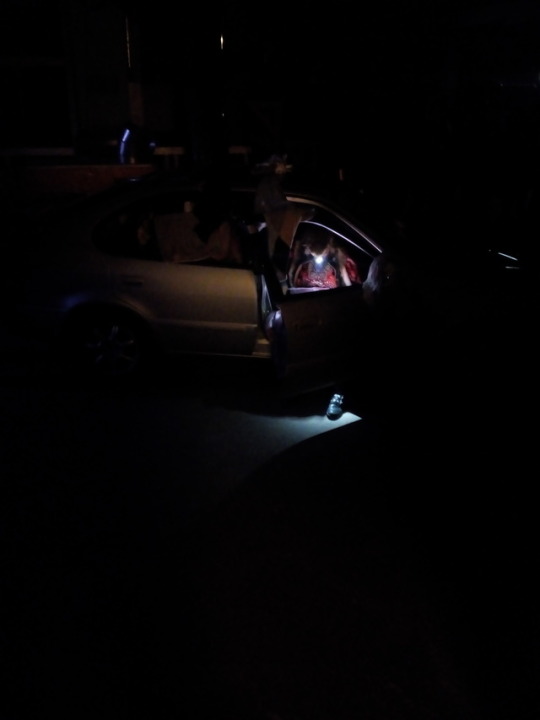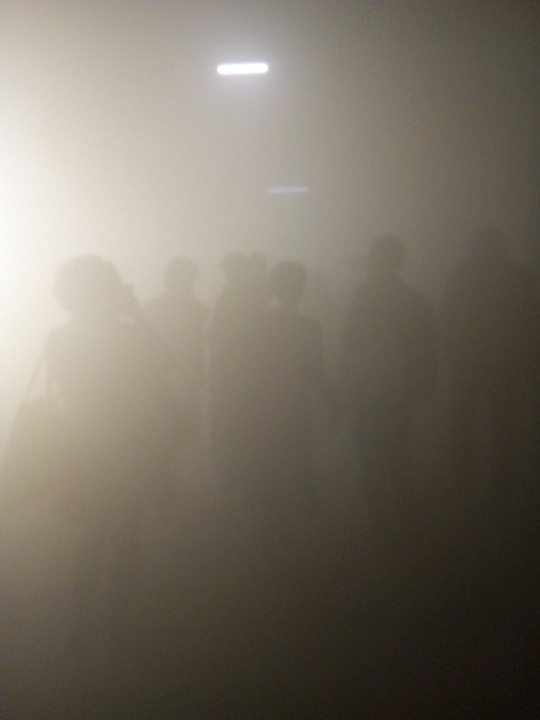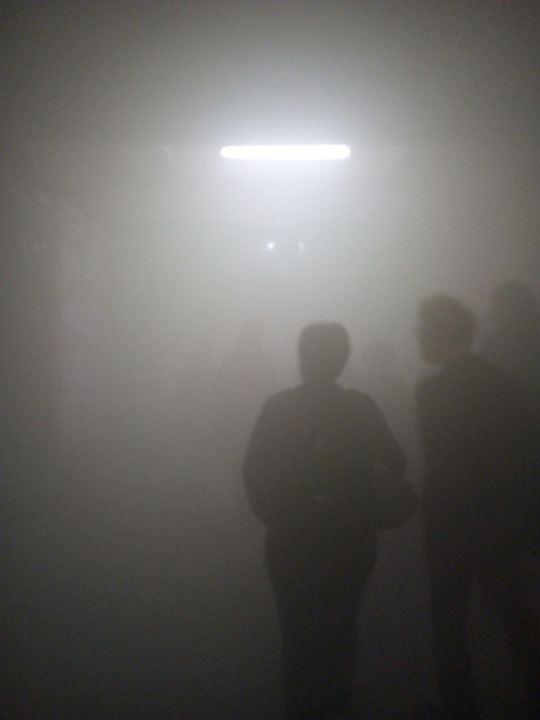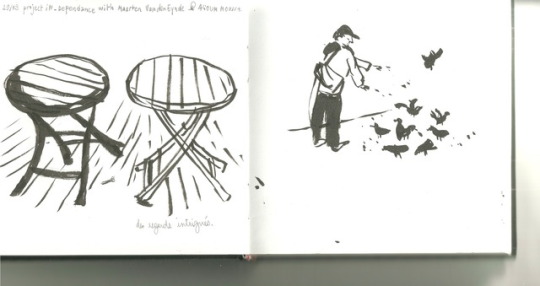#performatik
Photo


Ancestral Ca2+ (2019) is being performed on the 22-23 March as part of Performatik Festival at Kanal-Pompidou.
0 notes
Photo





30.03.2017
MEG STUART / DAMAGED GOODS, JEROEN PEETERS & JOZEF WOUTERS
ATELIER III
0 notes
Photo

0.PERFORMATIK
How can dance and architecture create a new kind of space together? During Performatik19, choreographer Radouan Mriziga will install a residency project at KANAL–Centre Pompidou. Using Bauhaus as a pedagogical model, he seeks to establish a contemporary educational practice that reformulates the models of space. He is inviting dance and architecture students to share their knowledge and practice. Projecting the resulting questions onto the surrounding workspace will create a new way of thinking and feeling space. Mriziga is thus building on his conviction that we can only think and act through a combination of body, mind, and intellect. Come and see the working process during the day or keep an eye on the performance schedule !
Concept Radouan Mriziga | with Radouan Mriziga, Maïté Jeannolin and students of dance and architecture training | dramaturgy Esther Severi.
https://kanal.brussels/fr/arts-vivants/0kanal
0 notes
Photo


Festival Performatik, 7 sérigraphie, “indépendance”
1 note
·
View note
Text
Eli Keszler announces three-song EP Empire on Shelter Press, drums up some tour dates
Avant-garde drummer, percussionist, amelerionist, violaskapa-ist, vibracelesta-ist (vibracellist? I mean, are these instruments even real?!) and generally trailblazing sound artist Eli Keszler has announced a new EP called Empire, out February 14 via Shelter Press. The brief three-song release follows Keszler’s ninth studio album Stadium, which was unveiled last October and made us collectively shit our pants, eventually landing at #11 of our favorite 50 music releases list.
Hey; speaking of Stadium: a repress of that album, currently sold out due to its unmitigated slaying, will be available on February 14 as well.
Keszler has also shared his touring/professoring/hanging out itinerary for the Spring. He will perform his own music at Montreal’s Mutek on February 23 and a couple of festivals in Europe, as a duo with Nate Boyce at the Fort Worth Modern Art Museum on February 28, and in Oneohtrix Point Never’s band in Chicago and London (check the full agenda below). Finally, he will also teach a course with Rashad Becker at CAMP in the Pyrenees in April.
Both Empire and the new pressing of Stadium can be pre-ordered now via Bandcamp. Listen to a fragment of the EP below:
Empire EP tracklisting:
01. Enter the Bristle Strum
02. Corrosion Kingdom
03. The Tenth Part of a Featured World
Eli Keszler tour dates:
02.15.18 - Chicago, IL - Pitchfork Midwinter #
02.21.18 - Boston, MA - Anderson Auditorium, School of the Museum of Fine Arts
02.23.18 - Montreal, Canada - Mutek, Phi Center
02.28.18 - Fort Worth, TX - Fort Worth Modern Art Museum %
03.06.18 - Amsterdam, NL - Muziekgebouw
03.08.18 - London, UK - The Roundhouse #
03.09.18 - Brussels, Belgium - Performatik, the Brussels Biennale of Performance Art
03.16.18 - Brooklyn, NY - Murmrr Ballroom &
03.29.18 - Braga, Portugal - Gnration
03.30.18 - The Hague, Netherlands - Rewire Festival
04.03.18 - Aulus-Les-Bains, the French Pyrenees - Why Do Stuff? Approaching Sound & Music from the Outside with Eli Keszler and Rashad Becker (not a performance)
04.26.18 - Malmo, Sweden - Intonal Festival
05.01.18 - London, UK - Kings Place
# Oneohtrix Point Never
% Nate Boyce
& Carl Stone http://j.mp/2SaRtNS
0 notes
Link
0 notes
Text
Hyperallergic: Making the Case for a More Inclusive Approach to Performance Art
Ivo Dimchev, AVOIDING deLIFEeath (all images courtesy Performatik17 and the artists)
BRUSSELS — Performance is an expansive field. Dance, live music, theater, social practices, burlesque, and opera all fall within its borders. Perhaps because it’s such crowded terrain, individual groups inhabiting it often guard their domains intensely. It’s less common for other disciplines to wage war over whether a work can properly be included within their fields. But those working with performance often take up these acts of exclusion with particular relish.
Perhaps the most protective of their territory are the folks known as performance artists. How precisely to define performance art, particularly in relation to theater, is a contentious question. Godmother of performance art Marina Abramović not only draws a line between the genres, but advocates an adversarial relationship, “… to be a performance artist, you have to hate theatre. Theatre is fake… The knife is not real, the blood is not real, and the emotions are not real.”
Theater artist Kristin Idaszak suggested the difference between theater and performance art is a question of the artist’s creative lineage (how they contextualize their own work) and the venue where they are presenting (whether it’s known as a theater, a peformance art venue, or something else).
Shannon Cochrane, head of FADO Performance Art Centre, offered a more direct (and humorous) line during a 2011 panel at Toronto’s Rhubarb Festival, “If there are chairs, it’s theatre. If there are no chairs, it’s performance art.”
So what to make of Performatik17, the 17th Brussels Biennial of Performance Art? Presented in numerous locations, including galleries, theaters, and site-specific venues, the event mixes dance, theater, intervention, social practice, and more. The biennial is either the dream of someone seeking an expanded field or the nightmare of someone craving rigid borders. The festival program calls it an “intriguing twilight zone where artists… tinker with the codes of the visual and performing arts.” Marina Abramović would not be impressed.
What we end up with is a mixed bag of artists investigating other disciplines. Sculptors take stabs at theater. Playwrights investigate durational performance. Choreographers explore interactive works. We also have plenty who remain within familiar territory, contributing works consistent with what they’ve made before.
Grace Schwindt, Opera and Steel
German-born, UK-based artist Grace Schwindt, is no stranger to performance. Featuring an acrobat, two dancers, an opera singer, and two musicians, her piece Opera and Steel looks at an ornithologist studying the effects of oil pollution on seabirds. The festival program identifies it as her first creation for the theater — a strange claim given the decidedly theatrical sensibility of her previous works like 2014’s Only a Free Individual Can Create a Free Society.
Part of the key to theater, to any time-based art consumed from beginning to end, is an understanding of how individual pieces relate to create an overall arc. Here, material is bizarrely ordered, with little sense of how sections interact, occasionally soliciting awkward laughs from the audience. Schwindt may want to instil confusion, mirroring the horror we feel at the fossil fuel industry’s destruction of the planet at the same time we struggle with our own culpability in this devastation. But the result seems more like an accident resulting from not understanding the form she’s investigating rather than something consciously produced.
Orla Barry, Breaking Rainbows
Orla Barry may be the world’s only artist-cum-shepherd. Along with her practice, she tends a flock of 80 sheep in Wexford, Ireland. Breaking Rainbows blends these worlds, combining two performers and nearly 700 pounds of raw wool. Aiming to “reflect upon the primal, poetic and unpredictable bond we have with the natural world,” the show fits easily within the theatrical genre, despite being presented in an art gallery
Breaking Rainbows is really two shows stuck together; a casual performance about a ram and the woman who wants to buy him and a series of (largely) scripted vignettes, randomly ordered based on papers pulled from a bag. It’s a quirky play you might see at a Fringe Festival. But its scripted nature places it decidedly outside the boundaries of performance art, even for the most open-minded viewer.
French theater director Philippe Quesne’s Caspar Western Friedrich is consistent with his own oeuvre and the wider genre of theater. Drawing inspiration from German Romantic painter Caspar David Frierich’s fondness for isolated figures in sprawling landscapes and the archetype of the cowboy (often imagined as a lonesome dude in a wide open space), the show features five cowboys mucking around a painter’s studio and, at times, inside paintings.
Philippe Quesne, Caspar Western Friedrich
The festival positions the work as a melding of genres because it’s a theater director exploring the works of a painter. But the show is solidly theater and there’s nothing wrong with that. While he doesn’t do so much to challenge theater’s conventions, Quesne creates one of the festival’s more satisfying performances that left me wanting to know more about the relationship between his subjects, proving you can challenge an audience without necessarily doing battle with form.
SSSSSSSSSSSS (Hiss It, Don’t Say It) by Lithuanian visual artist Ieva Misevičiūtė unfolds against the backdrop of the Galleries Royal Saint-Hubert (a posh, glass-roofed shopping street in the city center). Sporting a red dress and black and white tights, she performs a solo dance about survival instincts. A crowd gradually gathers as she performs. Elderly couples try to avoid her unpredictably swinging arms as they pass. Shopkeepers occasionally push through with carts full of garbage.
It’s a puzzling work to read, particularly in this space. But as Kristin Idaszak suggests, creative lineage may provide some clues to the artist’s intentions. Misevičiūtė’s background is in circus, specifically clown, so perhaps this should influence our reading of the work. A clown’s performance is fundamentally about watching someone fail, usually over and over. If clowning is an element here, then the show makes more sense. In that case, we’re not supposed to be moved by her eratic dancing in a posh shopping mall. We’re supposed to find it humorous.
Ieva Misevičiūtė, “SSSSSSSSSSSS (Hiss It, Don’t Say It)”
Ivo Dimchev is often referred to as a choreographer. But the Bulgarian artist’s oeuvre includes painting, sculpture, poetry, and music. His dance works often feature more talking than moving (not uncommon in contemporary dance). But he’s chiefly made a name for himself by pushing against the constraints Abramović applies to theatre. His performances make liberal use of his own blood (sometimes by cutting himself, sometimes by drawing it out with a syringe).
Employing these tropes of performance art in the theater has been a big part of his success, and provoked distaste among certain circles that consider him a shock artist. AVOIDING deLIFEeath reverses things, however, bringing elements of his theater making into a performance art context. Presented over six consecutive days for 14 hours at a stretch, audiences can watch Dimchev as he scores music, writes text, paints, and shoots videos.
Durational performance art is not usually intended to be watched beginning to end. Viewers might drop in at different points, witness only the beginning or ending, or not see the work at all, instead experiencing it through the documentation. But with Dimchev, as the hours clicked by, I felt no desire to leave the space. I was totally comfortable being there with him, observing his process.
How you might react to Performatik’s programming, depends on your perspective. Artists of the Abramović lineage would bristle at the inclusion of so obviously theatrical works in an event billing itself as a performance art biennial. But perhaps there’s something to be gained from all of these genres rubbing up against each other in the same context. It may be the friction of these edges causes them to slowly wear down, showing us that individual genres can survive on their own without being absorbed or annihilated by others.
If there’s a lesson to be gained here, it may be that the boundaries between genres of performance are not only artificial, but unnecessary. Instead of standing sentinel, guarding their territories, perhaps performance artists can open their borders and create space for other works to flow in.
Performatik17 continues at various venues throughout Brussels, Belgium through April 4.
The post Making the Case for a More Inclusive Approach to Performance Art appeared first on Hyperallergic.
from Hyperallergic http://ift.tt/2oqpLLs
via IFTTT
0 notes
Text
Extase of kunst?
Bij ‘draaiende derwisjen’ denkt u vast aan sufi-folklore:
youtube
Kunstenares Germaine Kruip was gefascineerd door dat oude Sufi-ritueel, dat de dansers in een staat van extase moet brengen.
Maar wat gebeurt er als de derwisjen stript van hun kostuums en ze zonder muziek laat draaien in een publieke ruimte? Dat onderzoekt Kruip in de reeks performances ‘A Possibility of an Abstraction: Square Dance;’ Bovendien laat ze de dansers ook nog eens in vierkanten dansen. Raken ze nog wel in trance? Is hun dans dan nog een ritueel? En hoe beleef je dat alles als toeschouwer?
vimeo
Dat kan u dit weekend zelf gaan uitzoeken. In het kader van Performatik brengt Kruip haar dansers naar de Horta-zaal in BOZAR. Alle info vindt u hier.
0 notes
Photo

Ancestral Ca2+ (2019)
Apass / Unsettled Study, curated by Vladimir Miller.
Performatik Festival
KANAL-Pompidou, Brussels
0 notes
Photo

31.03.2017
TRAJAL HARRELL
CAEN AMOUR
0 notes
Text
Interview with Mette Edvardsen
Can you tell me something about the title Black?
Mette Edvardsen: The title came early in the process and captured the initial questions I was busy with. It also refers to the objects I was working with parallel to the process. Objects you find in a theatre, like a little step at the end of the stage, or a box to place a projector on, painted black so that they are not so visible, but also objects I have used in my pieces, like a bottle, a cup, a chair, painted black to try to make them disappear. The piece tries to work with the border of things, between halfway visible and not visible at the same time. Through speech I try to make things appear. Black is also the dark, where no light reflects or all light is absorbed.
How will speech function in the piece?
Edvardsen: The starting point did not arise from a question about speech or language, but in response to my previous works and my relation to objects. This piece is a questioning of the objects: why are they here? What is my relationship with them? For Black I wanted to work in a space where there is nothing, all the objects are gone. I was interested to try to make something with nothing, so then in an empty space there was my body moving and talking. In the first place I relate to words and not to sentences. I use speech as a transmitter and I see myself as a medium between what is there and what you can see. I can imagine seeing things you can’t, and through speaking and relating to them, these things can become visible to you.
Aspects like emptiness, absence and presence of objects recur in your work
Edvardsen: In one way I think that all my works belong together and reflect upon each other. Each work is another aspect, another point of view, or a new question about the same things. For me the work is more about the experience it offers and what that evokes, than the story it tells. I am trying to create a language. Relating to what objects are, I work together with them, as my collaborators, they have a very specific function. In ‘Black’ I need to perform and activate objects that aren’t there, and that becomes the writing of the piece.
You often use repetition as a strategy
Edvardsen: I have worked with repetition before as a strategy. It was a way to work with details and a quite complex scene. By repeating it several times it was possible for the scene to unfold and for things to be seen. For me it is a way of activating things. I am not interested in the things in themselves, but the fact that we are interested in them. I am interested in how situations leave traces in the memory, and how memory becomes an active part of our reading of something. In ‘Black’ I use repetition again, but here the repetition is to sustain the moment, or the thing, to insist on its existence.
#mette edvardsen#mette-edvardsen-black#performatik#interview#mdtsthlm#choreography#art#performance art
0 notes
Photo










IVO DIMCHEV
AVOIDING DELIFEATH
Last party/ 30/03
0 notes
Photo






27/03
ALIOUM MOUSSA & MAARTEN VANDEN EYNDE
IN_DEPENDENCE
---Little things around the caravane----
0 notes
Photo



26/03 CHARLEMAGNE PALESTINE
STRUMMMINGGG IN CHARLEWORLDDD!!!
0 notes
Photo


26/03
FEIKO BECKERS
A DISAPPOINTMENT YOU CAN RELY ON
0 notes
Photo






26/03
PHILIPPE QUESNE & MÜNCHNER KAMMERSPIELE
CASPAR WESTERN FRIEDRICH
0 notes